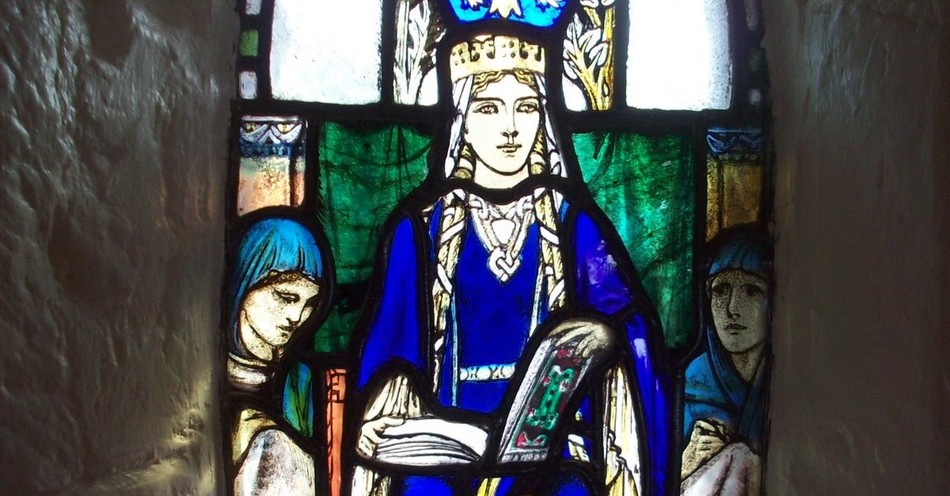When we think of the saints of the church, we tend to think about nuns, monks, bishops, or priests who dedicated their lives to God while remaining almost unknown to the rest of the world. Yet, a few saints are well-known by the church and society. Today’s saint and figure in the church is no exception.
St. Margaret of Scotland’s story overcame me as I learned more about the early church before the Great Schism of 1054. She was a key member of the Scottish royalty line and a faithful woman to God from childhood to her passing. Whether you belong to a high church denomination (as I do) or consider yourself an evangelical, her devotion to God has many great lessons for us.
When Was St. Margaret of Scotland Born?
St. Margaret was not Scottish by birth. She was English and Hungarian through her parents, Princess Agatha of Hungary and Prince Edward the Exile of England. Originally in exile around her birth in 1045 AD, her family returned to England hoping that Edward may not be reentered into the royal family but possibly be the next successor.
In 1066, King Edward the Confessor passed away, and the progression to name the next in line was anything but harmonious. Originally, it was to go to Harold Godwinson, but he could not hold the throne for long. So, Edward the Exile was next in line. Unfortunately, Edward passed away just months after arriving in England.
While St. Margaret and her sisters remained on the English court, conditions worsened. A fight for the throne followed, with one claimant, William the Conqueror, willing to bring violence. With the approval of Pope Alexander II, William invaded England and claimed authority to the throne and the church. As William continued his quest, his preferred church bishops and clergy replaced those in office.
Fearing for their safety, St. Margaret and her immediate family sailed north towards Scotland, hoping to seek refuge under the Scottish monarchy with King Malcolm III on the throne.
When they arrived, getting Malcolm’s aid required making a life-changing choice.
Who Did St. Margaret of Scotland Marry?
Dan Graves discusses St. Margaret’s marriage to Malcolm:
“The storm that blew all night drove the refugee ship off course. Edward the Etheling, his sister Margaret, and her mother Agatha were trying to return to Hungary, where they had formerly spent some years in exile. But instead, dawn revealed that they were off the rocky shore of Scotland in the year 1066.
The ship landed. King Malcolm III of Scotland was away, maneuvering against William the Conqueror, the Norman whose claim to England had forced the royal family to flee. Scotland took the refugees to heart. When Malcolm returned from war, he fell in love with beautiful Margaret. But Margaret was not eager for marriage. She wanted to become a nun.
Crude but goodhearted, Malcolm finally convinced Margaret to marry him. She became his queen. It is told that she slipped out nights to pray for her husband in a cave. Rumors attributed her absences to a plot against the kingdom. But the king soon learned the truth. Her godly influence transformed him, his court, and the nation.
Her confidence in God worked on the king’s nature. Malcolm listened to her because she gave good advice. Her faith gave her wisdom and insight and her reading gave her knowledge. She taught him to control his temper and instructed him in the manners of the civilized world. Malcolm and Margaret prayed together. With their own hands they fed crowds of poor people.
As the leading lady of Scotland, she set an example of holiness and personal worship for the court. Many of the ladies of the court imitated her behavior. At her patient insistence, Sunday became the day of rest and worship that it was meant to be. She set an example of charity by personally taking in at least nine orphans.
Before Margaret came to Scotland, ignorance ruled the land. Religious observances had slipped into error. At her insistence, a synod (council of church leaders) corrected the abuses.
The gracious queen loved to read, especially the gospels, with their glorious tale of God giving up glory that mankind might find it. An illuminated gospel that she treasured survives today. She sponsored new churches and improved existing ones so that the people might be attracted to Christianity.
Margaret loved color and soft cloth. She imported skilled workers to train the Scots to make such cloth. In this way, clan tartans owe their origin to her.
Malcolm and Margaret had six sons and two daughters whom she reared in her faith.
In light of Margaret’s remarkable story, we must believe that it was no mere chance that sent her to Scotland. Clearly God meant for her to perform a missionary work, and she fulfilled her responsibility. That is why a feast is held for her on this day, June 10, each year.
Bibliography:
1. Butler, Alban. Lives of the Saints. Westminster, Maryland: Christian Classics, 1981, 1956.
2. Huddlestone, G. Roger. “Margaret of Scotland.” The Catholic Encyclopedia. New York: Robert Appleton, 1914.
3. “Margaret of Scotland.” The Oxford Dictionary of the Christian Church. Edited by F. L. Cross and E. A. Livingstone. Oxford, 1997.
4. Steedman, Amy. “St. Margaret of Scotland.” Catholic Information Network. http://www.cin.org/margsc1.html
5. “St. Margaret of Scotland.” Women of Scots Descent. http://www.electricscotland.com/history/women/wih2.htm
6. Various encyclopedia and internet articles.
Last updated May 2007.”
(“Scotland’s Queen Margaret” by Dan Graves, MSL, first appeared on Christianity.com on May 3, 2010)
What Are Some of St. Margaret of Scotland’s Key Contributions to Christianity?
While St. Margaret originally intended to become a nun, she accepted King Malcolm III’s marriage proposal. Even after marrying, she contributed greatly to the reputation of the monarchy and the church. Known greatly for his temper, St. Margaret managed to lower this unfortunate trait in King Malcolm while finding favor in his eyes and heart as she reshaped the monarchy and reformed the Celtic Church.
For starters, she was known for her humility and generosity as she gave money and clothes away to the poor while opening the kingdom doors to give food to the starving and provide shelter for children, considering she was a refugee before. Overseeing all domestic affairs, St. Margaret had the final say on many things related to the poor and the state. It reached the point where even education was improved, from teaching to promoting the arts and literature. To make the life of the people even better, St. Margaret decreed Sunday to be a day of rest each week from a majority of labor. Along with this, rest destinations were also built for pilgrims traveling to venerate the relics of St. Andrew the Apostle. To ensure safe and free travel, St. Margaret decreed all ferry boats taking pilgrims to St. Andrew’s Cathedral to be free and covered by the monarchy and that any financial charge was deemed illegal and punishable by law.
On religious matters, Celtic Christianity needed to be reformed if it were under Rome’s leadership and guidance. Bishop Turgot of St. Andrew’s explains some conflicts between the Roman and Celtic clergy in his account of St. Margaret’s life. One conflict regarded pagan rituals the Celtic clergy had brought into the mass. Enraged, St. Margaret defended her position, stating, “Shall no one that is a sinner taste that holy mystery? If so, then it follows that no one at all should receive it, for no is pure from sin . . . and if no one ought to receive it, why did the Lord make this proclamation in the Gospel?”
After quoting John 6:52-59, St. Margaret proceeds to state, “It is a man who, without confession and penance, but carrying with him the defilements of his sins, presumes to approach the sacred sacrament…who eats and drinks judgment upon himself.”
Her speech continued, pointing out the flaws and abominations in pagan practices, reiterating Scripture. According to Bishop Turgot, “To these arguments, they could not answer a word… Fired by the zeal of God, the Queen attempted to root out and abolish [these] customs, so that henceforth, from the whole of Scotland, there was not one single person who dared to continue the practice.”
St. Margaret was a tender mother devoted to raising six biological children and teaching two more from King Malcom’s previous marriage, ensuring they were well taught and brought up learning and living virtuous lives dedicated to God. She devoted hours to fasting and prayer, even during bed rest when pregnant.
From her duties as Queen, church reform leadership, and maternal responsibilities, St. Margaret lived a life dedicated to God, spreading and teaching the Word, and the life of prayer. As Turgot explained, “For everything that she proposed, she supported so strongly by the testimonies of the Sacred Scriptures and the teaching of the Holy Fathers, that no one on the opposite side could say one word against [her].”
Despite all her accomplishments, St. Margaret threw herself into deep repentance, seeking any error in her ways. She longed to purge herself from sins, becoming evermore devoted to Christ.
When Was St. Margaret of Scotland Canonized?
St. Margaret would continue in her work, prayers, and fasts until passing away in November 1093, just weeks after King Malcolm died in battle at the hands of King William II Rufus.
Her health worsened, and she lamented to Turgot that great darkness would soon fall on Scotland. A few days later, on November 13, a report arrived that King Malcolm was slain in battle. When given the news, she glorified God by saying, “I give my praise and thanks to Thee, Almighty God, for that Thou hast been pleased that I should endure such a deep sorrow at my departing, and I trust that by means of this suffering, it is Thy pleasure that I should be cleansed from some of the stains of my sins.”
Three days later, on November 16, 1093, St. Margaret of Scotland passed away. Her son, Edgar, inherited the throne, followed by two more of her sons. Pope Innocent IV canonized her as a saint in 1250. She is also recognized and respected by the Eastern Orthodox Church.
What Is St. Margaret of Scotland the Patron Saint Of?
St. Margaret was more than a wife to children born in the faith. She led a country back to God, was defiant against heresies and paganism, reformed Catholic teaching and education, and stood for the oppressed by giving away possessions and instituting new laws. She was created for more than one specific role.
Her devotion to her God, family, and country exceeded her reputation. As a result, St. Margaret’s coming into sainthood made her the patron saint of large families, mothers, widows, queens, children, education, parents who lost their children, and Scotland as a whole, all while being known as “The Pearl of Scotland.”
Photo Credit: Erfurth/Wikimedia Commons
Trey Soto holds a B.A. in Communication Studies from Biola University and an M.A. in Communication Management from the University of Denver. He is a photographer, a writer, and a podcast host at T.V. Trey Podcast. You can see more of his work on his Wix portfolio.
This article is part of our People of Christianity catalog that features the stories, meaning, and significance of well-known people from the Bible and history. Here are some of the most popular articles for knowing important figures in Christianity:
How Did the Apostle Paul Die?
Who are the Nicolaitans in Revelation?
Who Was Deborah in the Bible?
Who Was Moses in the Bible?
King Solomon's Story in the Bible
Who Was Lot's Wife in the Bible?
Who Was Jezebel in the Bible?
Who Was the Prodigal Son?









